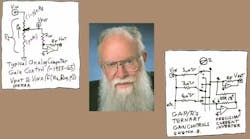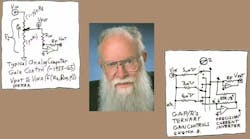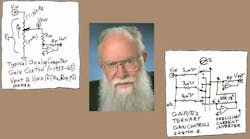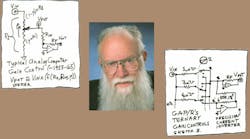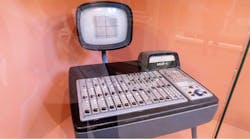This is part 1 of a 4 part series on analog computing.
I first joined George A. Philbrick Researches back in 1961, when Philbrick was doing some of the advanced analog computing stuff in the industry. (Note: for you young kids who weren't around then, I will explain everything later.)
At that time, Philbrick made analog computing modules—adders, subtractors, scalers, integrators, and analog multipliers/dividers—and several kinds of operational amplifiers, made with vacuum tubes, that ran on ±300 V dc. We had fun and were profitable. (We also were expanding into solid-state amplifiers, but I will explain that another day.)
What were analog computers good for? They were good at a lot of computing tasks that modern digital computers can now do. They also could simulate functions that Spice has learned to do. Of course, like any modern computer, and as with Spice, they had definite limitations if the models were lousy. In the old days, models were oversimplified—and lousy. In the modern era, modeling is still often lousy. No surprises there.
They could simulate a lot of mechanical systems and other kinds of physical systems, such as thermal and hydraulic systems. That was the whole reason for having them in the first place. (I'll expand on this shortly.)
In their day, these systems could simulate a lot of megabytes per second—in terms of resolution of several variables. Even better, they could display their results on a big cathode-ray tube (CRT), so users could compare the output variables.
What were the weaknesses? There were dynamic ranges that were hard to compute well with full accuracy. (The upcoming digital systems were substantially unlimited, in theory, for dynamic range.) They were expensive. They were not very easy to maintain or calibrate. This is true for most analog computers in the industry. Moreover, they were difficult to program. You had to know a lot about the system, about voltages, and about scale factors—to make it make sense when you ran the computer.
On a good day, these analog computing systems were "panceleric." That is, they could run at high speeds, or at slow speeds. Unfortunately, the high- and low-speed results didn't necessarily match. That's not a disaster, but it causes a confidence problem. On a good day, you could turn one knob, or dial, and watch the outputs change until you got an answer that you liked—or until you got an answer from which you could learn something. I like that part.
I plan to talk about many aspects of analog computation during the next year, especially operational amplifiers, which we now call "op amps." But to run the operational amplifiers of 1960, which required ±300 V dc, you need a good, stable power supply. I recently got a good old ±300-V supply, an R-300 from 1968. I will talk about it first, and some of the very good features of its design in the next column. To make a good voltage regulator, you need some good special-purpose op amps.
Philbrick is no longer in business. Teledyne acquired Philbrick about 30 years ago, and it then merged with Nexus Research Labs (one of Philbrick's spinoffs). Teledyne Philbrick Nexus ran for several years, then merged with Teledyne Components, formerly Amelco. In about 1985, Teledyne spun this off into Telcom. Most Philbrick products are now dead, but you can still buy a few from Telcom.
Long live Philbrick!—and the analog computers—and analog concepts—and the op amps that it helped introduce to the world!
More About Knots: Many people commented on "What's All This Knot Stuff, Anyhow? (Part I)" (electronic design, March 5, 2001, p. 142). Several readers noted that I hadn't drawn a proper bowline knot, but rather a "Dutch bowline," which supposedly has some disadvantages. Well, I stand corrected. Several claimed to have never experienced bowlines coming untied. It's true that with some kinds of ropes, knots stay tied. But with other types or sizes of rope, knots—even good ones—tend to untie, especially if they can get slack.
The good old 1960 book, Mountaineering—Freedom of the Hills (p. 117), specifically recommends that half-hitches be used to "back up a bowline...for bowlines are especially prone to working loose." This book has no ISBN number, but its Library of Congress number is 60-8907. It was published by The Mountaineers, Seattle, Wash.
—RAP
Embarrassing Typo Error: In the recent "Equations Stuff (Part 3),"(electronic design, Nov. 5, 2001, p. 94), I typed out that the response of the filter is:
VOUT /VIN = Gain =
1/\[1 + pC1(R1+R2) + p2R1C1R2C2\]
Actually, the C1 in the middle term was typed wrong; it should be C2:
VOUT /VIN = Gain =
1/\[1 + pC2(R1+R2) + p2R1C1R2C2\]
All for now. / Comments invited!
RAP / Robert A. Pease / Engineer
[email protected]—or:
Mail Stop D2597A
National Semiconductor
P.O. Box 58090
Santa Clara, CA 95052-8090
About the Author

Bob Pease
Bob obtained a BSEE from MIT in 1961 and was a staff scientist at National Semiconductor Corp., Santa Clara, CA, for many years. He was a well known and long time contributing editor to Electronic Design.
We also have a number of PDF eBooks by Bob that members can download from the Electronic Design Members Library.
